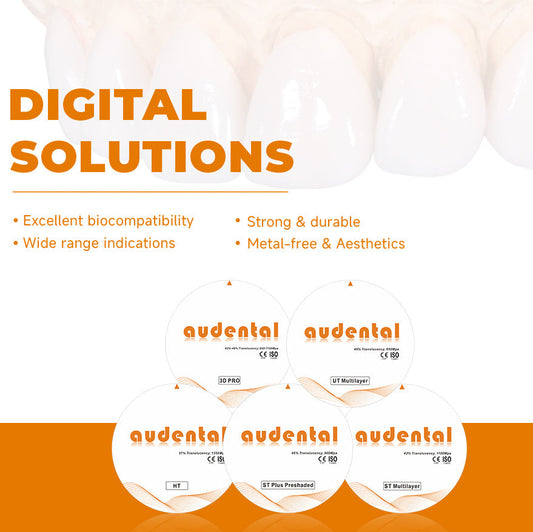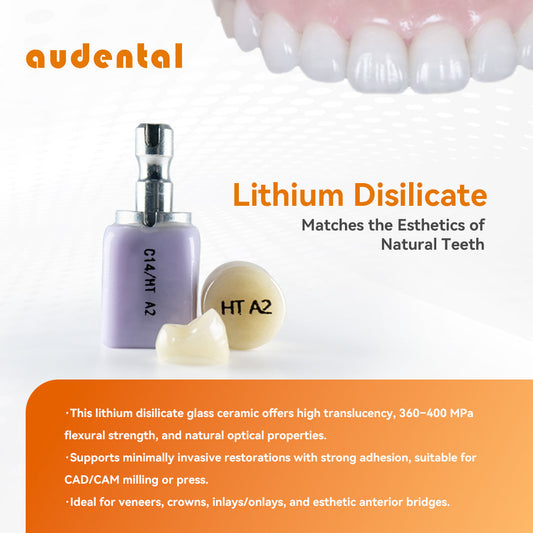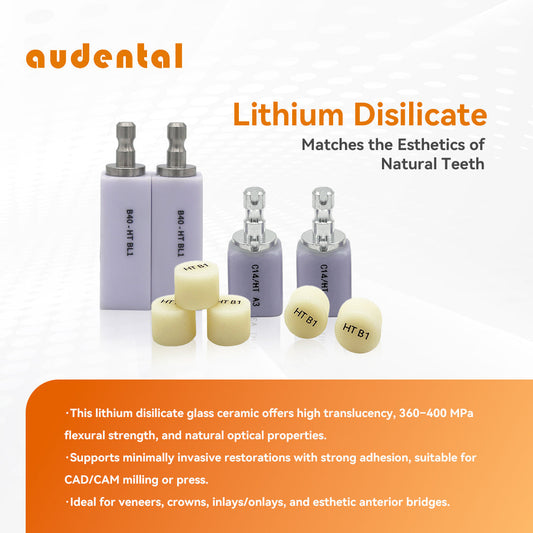Ideal Applications of Audental Lithium Disilicate for Veneers and Inlays/Onlays
Share
1. What Are Dental Veneers?
Veneers are thin ceramic facings bonded to the labial/buccal surface of anterior teeth to enhance color, shape, proportion, and minor alignment—delivering both aesthetic and functional improvements.

Key Advantages of Veneers:
- Minimally invasive, enamel-preserving: Typically only 0.3–0.7 mm enamel reduction, maximizing natural tooth preservation.
- Excellent aesthetics: Lifelike translucency and fluorescence allow natural shade masking and refined texture, proportion, and incisal effects.
- Color stability & stain resistance: Glazed, dense ceramics with precise margins reduce long-term discoloration and staining.
- Reliable adhesion: Strong, durable bonding to enamel through micro-mechanical retention and chemical coupling improves marginal longevity.
- Fast smile makeover: Effective for tetracycline/fluorosis discoloration, diastema closure, minor wear, and small fractures.
- High customization: Layering, incisal translucency bands, and texture can be tailored for a natural—not “over-whitened”—look.
Best for: anterior aesthetic enhancement, mild-to-moderate shape/length rebuild, small chips and space management.
2. What Are Inlays/Onlays?
Inlays and onlays restore posterior teeth or any area requiring load-bearing. They rebuild anatomy and disperse stresses via cavity design plus adhesive bonding—often replacing large direct fillings and reducing the need for full crowns.


Inlay Onlay
Key Advantages of Inlays/Onlays:
- Tooth preservation with reinforcement: Compared with full crowns, more healthy tooth structure is preserved—only weak or carious tissue is removed.
- Strong mechanical performance: Dense, wear-resistant ceramics; cusp-coverage onlays/overlays reduce crack propagation and chipping risk.
- Tight margins & durability: Lab-made fit plus adhesive cementation improve marginal integrity and reduce secondary caries/microleakage.
- Precise occlusal anatomy: Digital design and milled/pressed fabrication deliver controlled contacts and occlusion.
- Maintenance-friendly: Hard glaze with excellent polishability keeps surfaces smooth over time, reducing stain accumulation.
- Upgrades failing large fillings: A more stable, longer-lasting solution for repeatedly failing composites or cracked-tooth cases.
Best for: large posterior defects, reinforcement of cracked teeth, recurrent failure of large direct restorations, and long-term stability in high-load zones.
3. Veneers and Inlays/Onlays—How to Choose?
| Dimension | Veneer | Inlay/Onlay |
| Primary region | Anterior aesthetic zone | Posterior/load-bearing (and selective anterior functional cases) |
| Primary goal | Color/shape/proportion aesthetics | Structural reinforcement, occlusal function, long-term endurance |
| Tooth preservation | Very high (often within enamel) | High (significantly more than full crowns) |
| Load capacity | Aesthetics-oriented; moderate load | Strong; suited to high loads and crack management |
| Aesthetic detailing | Highly customizable layering/texture | Aesthetic options available, but function/endurance prioritized |
| Typical alternative | Composite veneer | Large direct filling/metal inlay/partial crown |
4. Materials & Workflow—Turning Advantages into Outcomes
- Lithium disilicate glass ceramics: The proven balance of beauty and strength (clinical range commonly 360–400 MPa). They etch with hydrofluoric acid and silanate for strong adhesion—ideal for both veneers and inlays/onlays.
- Pressable (hot-pressed) ceramics: High density and crisp margins—excellent when precise contacts and edge definition are critical, for either veneers or indirect posterior restorations.
- Audental Glass Ceramics (CAD/CAM): Suitable for veneers and inlays/onlays; milled restorations with fast crystallization, high efficiency, and clean margins. Pair with Audental Glaze & Stain for one-step shading that achieves natural glaze effects.
- Audental Pressable Ceramics (Pressable Ingots): Hot-pressed for dense microstructure and sharp edges, offering excellent marginal integrity and contact control—favored by technicians who value wax-up precision.
5. Audental Solutions
1) Audental Glass Ceramics
Indications/Use Cases: Veneers, inlays/onlays, anterior and posterior crowns, and short-span anterior bridges.
Material Features:
- High translucency and natural light scattering create depth of color without an overly “bright-white” effect.
- Stable mechanical performance (360–400 MPa) with excellent edge-chipping resistance.
- Milling-friendly behavior and strong margin integrity reduce micro-defects.
- Fast crystallization workflow: single-stage crystallization shortens chairside and laboratory turnaround.
- Offered in common shade ranges and multilayer options; compatible with the Audental Glaze & Stain system—one-step staining achieves a glazed finish (no separate powder–liquid mixing required).


2) Audental Pressable Ceramics
Indications/Use Cases: Veneers, inlays/onlays/overlays, and anterior/posterior crowns where marginal fit and morphological detailing are critical; ideal for technician teams favoring traditional hot-press workflows and wax-up techniques.
Material Features:
- Hot-pressed, high-density microstructure with crisp, sharp margins—excellent for precise edge and contact control.
- Outstanding stratification and optical transitions for a natural aesthetic without a “chalky” appearance.
- Multiple translucency levels and ingot shades, covering cases from opacious masking to high translucency.
- Factory-matched crystallization and staining systems; after pressing, proceed directly to individualized staining and glazing.






